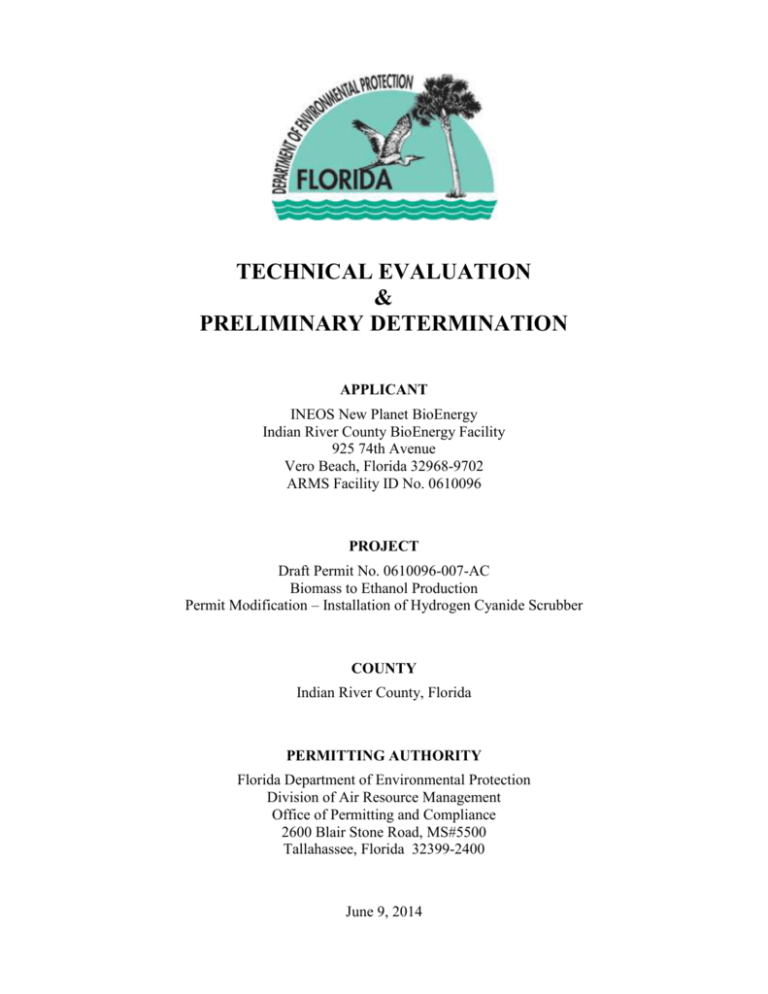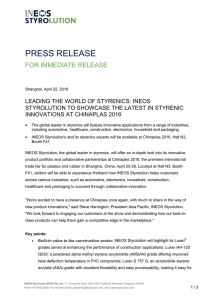U0001954 - Florida Department of Environmental Protection
advertisement

TECHNICAL EVALUATION & PRELIMINARY DETERMINATION APPLICANT INEOS New Planet BioEnergy Indian River County BioEnergy Facility 925 74th Avenue Vero Beach, Florida 32968-9702 ARMS Facility ID No. 0610096 PROJECT Draft Permit No. 0610096-007-AC Biomass to Ethanol Production Permit Modification – Installation of Hydrogen Cyanide Scrubber COUNTY Indian River County, Florida PERMITTING AUTHORITY Florida Department of Environmental Protection Division of Air Resource Management Office of Permitting and Compliance 2600 Blair Stone Road, MS#5500 Tallahassee, Florida 32399-2400 June 9, 2014 TECHNICAL EVALUATION & PRELIMINARY DETERMINATION 1. GENERAL PROJECT INFORMATION 1.1. Facility Description and Location INEOS New Planet BioEnergy, LLC (INPB) is operating the Indian River County BioEnergy (INEOS Bio) facility to produce ethanol from a biomass feedstock consisting of mostly vegetative yard waste, clean woody biomass, construction and demolition (C&D) debris and municipal solid waste (MSW). The INEOS Bio facility is located near Vero Beach in Indian River County (IRC), Florida. Specifically, the INEOS Bio facility is at the former location of an Ocean Spray citrus processing facility at the intersection of 74th Avenue and Oslo Road near Interstate 95. The UTM coordinates are Zone 17, 550.7 kilometers (km) East and 3,051.3 km North. The location of Indian River County in Florida is shown in Figure 1, while an aerial view of the INEOS Bio facility is shown in Figure 2. Indian River County Figure 1- Indian River County, Florida. Figure 2– Aerial View of INEOS Bio Facility. Construction of the facility has been completed with the facility operating at a minimal level and currently not utilizing MSW as a feedstock. When operating at full capacity, the facility is expected to produce up to 8 million gallons per year (MGPY) of ethanol. The facility can also generate a small amount of electrical power available for commercial use: about 6 megawatts (MW) gross, with a net of 2 MW-net exported to the grid. The facility is categorized under Standard Industrial Classification (SIC) Code No. 2869 - Industrial Organic Chemicals, Not Elsewhere Classified. The Florida Department of Environmental Protection (Department) previously authorized construction of the facility pursuant to air construction Permit No.0610096-001-AC with several subsequent modifications to the original permit. Electronic copies of all previous air permit applications and issued permits packages are available at the following web link: http://www.dep.state.fl.us/air/emission/bioenergy/indian_river.htm 1.2. INEOS Bio Facility Process Overview When fully operational, the primary feedstock for the facility will be biomass, MSW, vegetative matter, yard waste, land clearing debris and untreated wood collected by the IRC Solid Waste Disposal District (SWDD) curbside collection program, delivered to the county's collection centers, or delivered directly to the facility by the public. It is anticipated that on an annual average, yard waste will make up approximately 90 percent (%) of the feedstock. The remainder of the feedstock will consist of the other components listed above. The INEOS Bio ethanol technology process gasifies the biomass feedstock. The organic material is not be directly combusted; instead, oxygen is supplied to the gasifier which converts the feed material into a synthetic gas (syngas) consisting of carbon monoxide (CO), carbon dioxide (CO2), hydrogen (H2) and other hydrocarbons. INEOS New Planet BioEnergy, LLC INEOS Bio Facility - Permit Modification Air Construction Permit No. 0610096-007-AC Indian River County Page 2 of 8 TECHNICAL EVALUATION & PRELIMINARY DETERMINATION Under most circumstances, this syngas is not directly combusted. Instead it is cleaned and cooled and then fed into a fermentation system where proprietary bacterial metabolic action converts the syngas into ethanol. The ethanol is then distilled, dehydrated, denatured, stored and loaded into dedicated ethanol tanker trucks for shipment offsite. Off gases from the fermentation process are routed to a fermentation vent gas boiler for combustion. Steam from the fermentation vent gas boiler as well as steam from waste heat recovery at the gasifiers is routed to a steam turbine electrical generator (STEG) to generate electricity. Vent gas boiler emissions are controlled by sodium bicarbonate injection to control sulfur dioxide (SO2), activated carbon injection (ACI) to control mercury (Hg and other metal hazardous air pollutants (HAP)) and fabric filtration to control particulate matter (PM). 1.3. Project Rational A revised facility plot plan is presented in Figure 3, which shows the location of the HCN scrubber stack. An overall facility process flow diagram is presented in Figure 4, which shows the general location of the HCN scrubbing system. A process flow diagram of the HCN scrubbing system is presented in Figure 5. Redacted INEOS New Planet BioEnergy, LLC INEOS Bio Facility - Permit Modification Air Construction Permit No. 0610096-007-AC Indian River County Page 3 of 8 TECHNICAL EVALUATION & PRELIMINARY DETERMINATION Figure 3. Revised Facility Plot Plan. Redacted Redacted Figure 4. Overall Facility Process Flow Diagram with HCN Scrubber Highlighted. Figure 5. A Process Flow Diagram of the HCN Scrubbing System. INEOS New Planet BioEnergy, LLC INEOS Bio Facility - Permit Modification Air Construction Permit No. 0610096-007-AC Indian River County Page 4 of 8 TECHNICAL EVALUATION & PRELIMINARY DETERMINATION 1.4. Primary Regulatory Categories The facility is not major source of HAP. The facility does not operate units subject to the acid rain provisions of the Clean Air Act. The facility is a Title V major source of air pollution in accordance with Chapter 62-213, Florida Administrative Code (F.A.C.) because Section 129(e) of the Clean Air Act requires Title V permits for all sources subject to an NSPS Subpart for solid waste combustion, which includes NSPS Subpart AAAA. The facility is not a major stationary source in accordance with Rule 62-212.400, F.A.C. for the Prevention of Significant Deterioration (PSD) of Air Quality. The facility operates units that are subject to the New Source Performance Standards (NSPS) at 40 Code of Federal Regulations, Part 60 (40 CFR 60), and the National Emissions Standards for Hazardous Air Pollutants (NESHAP) at 40 CFR 63. Table 1 gives a list of the emission units (EU) at the facility. This permitting action will not result in the elimination or addition of any emission units. However, the wet scrubber installation will affect EU 003 the Gasification, Fermentation and Distillation Systems (highlighted in yellow). TABLE 1 – LIST OF THE EU AT THE INEOS BIO FACILITY. EU No. 001 002 003 004 006 007 008 010 011 1.5. Emission Unit Description Materials Handling Area Feedstock Dryers No. 1 and No. 2 Gasification, Fermentation and Distillation Systems Distillation Unit Fugitive Emissions Vent Gas Boiler Tank Farm Loadout Flare Syngas Flare Emergency Equipment Processing Schedule May 22, 2014: June 9, 2014: Department received the application for an air pollution construction permit modification. Department distributed written Intent to Issue Air Permit and posted documents. 2. APPLICABLE REGULATIONS 2.1. State Regulations This project is subject to the applicable environmental laws specified in Section 403 of the Florida Statutes (F.S.). The statutes authorize DEP to establish rules and regulations regarding air quality as part of the F.A.C. This project is subject to the applicable rules and regulations defined in the following chapters of the F.A.C (see Table 2). TABLE 2 – LIST APPLICABLE STATE REGULATIONS FROM F.A.C. Chapter 62-4 62-204 62-210 62-212 62-213 Description Permits Air Pollution Control – General Provisions Stationary Sources of Air Pollution – General Requirements Stationary Sources – Preconstruction Review Operation Permits for Major Sources (Title V) of Air Pollution INEOS New Planet BioEnergy, LLC INEOS Bio Facility - Permit Modification Air Construction Permit No. 0610096-007-AC Indian River County Page 5 of 8 TECHNICAL EVALUATION & PRELIMINARY DETERMINATION Chapter 62-214 62-296 62-297 Description Requirements for Sources Subject to the Federal (Title IV) Acid Rain Program Stationary Sources – Emission Standards Stationary Sources – Emissions Monitoring The following are specific state regulations that are applicable to this project: 2.2. Chapter 62-213, F.A.C. Operation Permits for Major Sources of Air Pollution (Title V). The facility will be a major source of air pollution under the Title V program. Subsection 62-296.320(1), F.A.C. VOC Emissions. This rule forbids the storage, pumping, handling, processing, loading, unloading or use of VOC without applying vapor emission control devices or systems. This rule could potentially apply to the INPB IRC facility Subsection 62-296.320(2), F.A.C. Objectionable Odor Prohibited. This rule prohibits any person from discharging air pollutants which cause or contribute to objectionable odors. At the INPB IRC facility, this rule will apply to the Materials Handling Area (EU 001). Paragraph 62-296.320(4)(b), F.A.C. General Visible Emissions Standard. This rule applies a visible emissions limit of 20 percent opacity for equipment that does not otherwise have limits for visible emissions or for PM. Paragraph 62-296.320(4)(c), F.A.C. Unconfined Emissions of PM. This rule prohibits industrial facilities from emitting unconfined PM (such as dust from unpaved roads) without taking reasonable precautions. Rule 62-296.416, F.A.C. Waste-to-Energy Facilities. The applicant and DEP have agreed that the rules for small MSW combustors will apply as the best regulatory fit for this process. This includes Rule 62-296.416, F.A.C., which limits Hg emissions from waste-to-energy facilities. Federal Regulations The U.S. Environmental Protection Agency (EPA) establishes air quality regulations in 40 CFR 60 that identifies NSPS for a variety of industrial activities. Part 61 specifies NESHAP based on specific pollutants. Part 63 specifies NESHAP provisions based on the Maximum Achievable Control Technology (MACT) for given source categories. Florida adopts these federal regulations in Rule 62204.800, F.A.C., and stationary sources in Florida are required to comply with the adopted federal regulations as per Subsection 62-296.100(3), F.A.C. The following federal regulations are applicable to this project: 40 C.F.R. part 60, Subpart A—NSPS General Provisions. The general provisions apply to all emissions units that are subject to one or more of the NSPS rules. 40 C.F.R. part 60, Subpart AAAA—NSPS for Small MWC. Currently, Subpart AAAA will apply to the gasification units/biological reactor/vent gas boiler train, with the point of comparison to the federal emission limits at the exit of the vent gas boiler stack and after the post-combustion air pollution controls. 40 C.F.R. part 60, Subpart Kb—NSPS for Volatile Organic Liquid Storage Vessels. This rule establishes design and emissions control criteria for certain storage tanks, as a function of their size and the vapor pressure of the organic liquid being stored. At the proposed facility, only the product storage tank and the denaturant storage tank will be subject to this subpart. 40 C.F.R. part 60, Subpart IIII—NSPS for Stationary Compression Ignition Internal Combustion Engines. This rule applies to the engines used to process the feedstock and the emergency equipment at the facility. 40 C.F.R. part 63, Subpart ZZZZ—NESHAP for Stationary Reciprocating Internal Combustion Engines. This rule applies to the engines used to process the feedstock and the emergency equipment at the facility. INEOS New Planet BioEnergy, LLC INEOS Bio Facility - Permit Modification Air Construction Permit No. 0610096-007-AC Indian River County Page 6 of 8 TECHNICAL EVALUATION & PRELIMINARY DETERMINATION 40 C.F.R. part 60, Subpart VVa—NSPS for Equipment Leaks of VOC. This rule limits fugitive emissions of VOC from leaking equipment (such as pumps, valves, flanges and connectors) through the implementation of a site-specific leak detection and repair (LDAR) plan. Federal regulations adopted by reference are given in Rule 62-204.800, F.A.C. State regulations approved by EPA are given in 40 CFR 52, Subpart K; also known as the State Implementation Plan (SIP) for Florida. On May 1, 2014, the EPA Administrator approved the Department’s SIP submittal related to regulation of GHGs, effective upon publication (May 19) in the Federal Register: Link to GHG SIP Approval. GHGs is defined at section 40 CFR 86.1818-12(a) as the aggregate group of gases including CO2, nitrous oxide (N2O), methane CH4, hydrofluorocarbons (HFCs), perfluorocarbons (PFCs), and sulfur hexafluoride (SF6). GHGs is expressed as CO2-equivalent (CO2e): Link to GHGs Definition. 3. PSD APPLICABILITY REVIEW 3.1. General PSD Applicability The Department regulates major stationary sources in accordance with Florida’s PSD program pursuant to Rule 62-212.400, F.A.C. PSD preconstruction review is required in areas that are currently in attainment with the state and federal ambient air quality standards (AAQS) or areas designated as “unclassifiable” for these regulated pollutants. PSD pollutants that are common to a facility such as INPB include: CO, nitrogen oxides (NOX), PM, PM with a mean diameter of 10 microns or less (PM10), PM with a mean diameter of 2.5 microns or less (PM2.5), SO2, volatile organic compounds (VOC), sulfuric acid mist (SAM), Pb, fluorides (F), H2S, HCl, Hg, MWC acid gases measured as SO2 and HCl, municipal waste combustor (MWC) organics measured as D/F and MWC metals measured as PM. As defined in Rule 62-210.200(Definitions), F.A.C., a stationary source is a “major stationary source” (major PSD source) if it emits or has the potential to emit (PTE): 250 tons per year (tons/year) or more of any PSD pollutant; or 100 tons/year or more of any PSD pollutant and the facility belongs to one of the 28 listed PSD major facility categories. The list given in the citation includes the category of “Chemical process plants”. This category applies to the INPB facility. The INPB facility is not a major stationary source because it does not have actual emissions or the PTE 100 TPY or more of any individual PSD pollutant. 3.2. PSD Applicability for the Modification Project Major facilities and major modifications (physical change) are required to undergo PSD review for each pollutant emitted in significant amounts to include: (1) a control technology review; (2) a source impact analysis; (3) an air quality analysis (monitoring); (4) a source information; and (5) an additional impact analyses. According to INPB, although addition of the HCN scrubber is a physical change, it will not increase emissions of any regulated PSD pollutant. Consequently, the facility is still not a minor source and not subject to a PSD review. The project will result in HCN emissions from the INEOS Bio facility when the scrubber system is installed. HCN is a listed HAP. According to INPB, the maximum potential annual emissions of HCN is 3.8 TPY, which is below the individual HAP threshold of 10 TPY for a major source of HAP emissions. The INEOS Bio facility is currently not a major source of HAP emissions with a maximum annual total HAPs emissions potential of 13.6 TPY. With the additional 3.8 TPY of HCN emissions, the total HAPs emissions potential will be 17.4 TPY, which is less than the total HAP emission threshold of 25 TPY for a major source of HAP emissions. As a result, with the HCN scrubber system installed, the INEOS Bio facility will remain as an area source (not major) of HAP emissions. INEOS New Planet BioEnergy, LLC INEOS Bio Facility - Permit Modification Air Construction Permit No. 0610096-007-AC Indian River County Page 7 of 8 TECHNICAL EVALUATION & PRELIMINARY DETERMINATION 3.2.1. Department Review The Department agrees with INPB that the installation of a scrubber to remove HCN from the syngas will not results in an increase in emissions of any regulated PSD pollution. With regard to the HAP (HCN) emission increase, the Department also concurs that due to the scrubbing of the syngas to remove HCN some emissions of this HAP will occur to the atmosphere. Consequently the Depart6ment will require an initial stack test on Tower 3 (Air HCN Scrubber) to verify the HCN emission rate of 3.8 TPY (0.87 pounds per hour). 4. PRELIMINARY DETERMINATION The Department makes a preliminary determination that the proposed project will comply with all applicable state and federal air pollution regulations as conditioned by the draft permit. This determination is based on a technical review of the complete application, reasonable assurances provided by the applicant and the conditions specified in the draft permit. David Read, P.E., is the primary processor for reviewing the application and drafting the permit. He may be contacted at (850) 717-9075 or by email at David.Read@dep.state.fl.us. INEOS New Planet BioEnergy, LLC INEOS Bio Facility - Permit Modification Air Construction Permit No. 0610096-007-AC Indian River County Page 8 of 8






